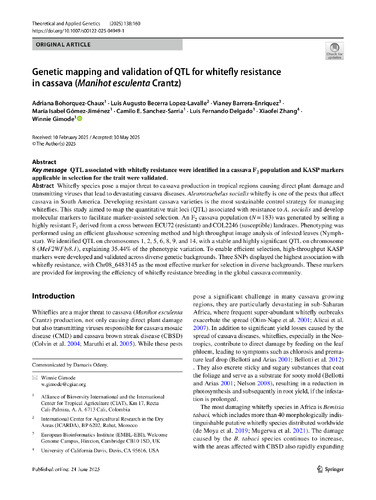QTL associated with whitefly resistance were identified in a cassava F2 population and KASP markers applicable in selection for the trait were validated. Whitefly species pose a major threat to cassava production in tropical regions causing direct plant damage and transmitting viruses that lead to devastating cassava diseases. Aleurotrachelus socialis whitefly is one of the pests that affect cassava in South America. Developing resistant cassava varieties is the most sustainable control strategy for managing whiteflies. This study aimed to map the quantitative trait loci (QTL) associated with resistance to A. socialis and develop molecular markers to facilitate marker-assisted selection. An F2 cassava population (N = 183) was generated by selfing a highly resistant F1 derived from a cross between ECU72 (resistant) and COL2246 (susceptible) landraces. Phenotyping was performed using an efficient glasshouse screening method and high throughput image analysis of infested leaves (Nymphstar). We identified QTL on chromosomes 1, 2, 5, 6, 8, 9, and 14, with a stable and highly significant QTL on chromosome 8 (MeF2WFly8.1), explaining 35.44% of the phenotypic variation. To enable efficient selection, high-throughput KASP markers were developed and validated across diverse genetic backgrounds. Three SNPs displayed the highest association with whitefly resistance, with Chr08_6483145 as the most effective marker for selection in diverse backgrounds. These markers are provided for improving the efficiency of whitefly resistance breeding in the global cassava community.
Bohorquez-Chaux, A.; Becerra Lopez-Lavalle, L.A.; Barrera-Enriquez, V.; Gomez-Jimenez, M.I.; Sanchez-Sarria, C.E.; Delgado, L.F.; Zhang, X.; Gimode, W.

